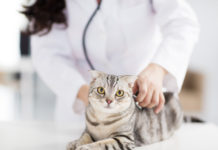Q. I have a yellow and white shorthaired male cat, 18 years old. As he got older, he began to have rough black spots on the skin on his ears, mouth and chin area, where fleas hide. What is this and can we help him with this? Sincerely, Spot’s Mom
A. First of all, I want to thank and congratulate you for the obvious care that you have provided and concern you have for your baby. Given his age, you have clearly done something (many things!) right, and today’s question is an extension of the dedication that you have shown.
A number of things can cause changes in pigmentation of a cat’s skin. Before discussing some potential causes, it’s important to stress that it is difficult to know specifically what is causing these changes without examining him, so it is important to have him examined by a veterinarian as the first step. The veterinarian may be capable of diagnosing and addressing the problem, or may refer you to a veterinary dermatologist.
Some processes leading to pigmentary changes in a cat’s skin are relatively benign, while others can be a significant concern. Generally, lesions that are raised, oozing, crusting, fluid filled, irregularly shaped, thickened and/or ulcerated are of greater concern.
Hyperpigmentation, or increased melanin in the skin, may be genetically based, acquired or associated with pigmented tumors. Among the more benign causes of hyperpigmentation is lentigo, which is usually seen in young cats, but may advance with age. Lentigo is characterized by flat, pigmented regions ranging in size from 1 to 10 millimeters that appear on the nose, lips, ears, eyelids and even occasionally on the gums and hard palate.
This hyperpigmentation, common in orange cats, is smooth and usually not thickened. Think of this as feline freckles. Lentigo is believed to have a genetic predisposition. Epidermal nevi are a more rare form of a genetically based hyperpigmentation that may sometimes form in linear tracts. Both lentigo and epidermal nevi are usually cosmetic, with little consequence for the affected kitty, although infection may occur, requiring medical attention.
Feline acne may develop in cats of any age, usually on the chin and lower lip. These lesions are often crusty and raised, and may become secondarily infected, requiring either topical cleaning and/or antibiotics or, in advanced cases, systemic antibiotics to address them.
Sometimes cats with conditions involving inflammation of their skin may develop increased pigment at the sites once it is resolved. In these cases, there is usually a history of prior redness, swelling and/or oozing at the affected sites.
A number of conditions that result in pigmented spots are of greater concern. Among the more common of these is melanoma. This is a cancer of the cells that produce the pigment melanin. Melanomas most commonly occur in cats between 10 and 11 years of age, and are often found on the head and neck. They are usually brown or black and may have variable shapes and range in size from 0.5 to 5 centimeters in diameter. Melanomas may become secondarily ulcerated. They should be treated aggressively by surgical removal with or without supplemental medical therapy, as they can spread and be life threatening. While it doesn’t sound like your kitty has melanoma, it is best to make sure and have these spots looked at promptly.
Since you mention that these spots are good places for fleas to hide, it is very important to treat any flea infestation that your kitty may have. Fleas can make us kitties very uncomfortable, result in secondary skin infections and allergies and even transmit intestinal parasites to us. Successful treatment usually involves treating your kitty and the home. Please discuss this with your cat’s veterinarian, and you and your kitty will be glad that you did.
—Sincerely, Elizabeth



